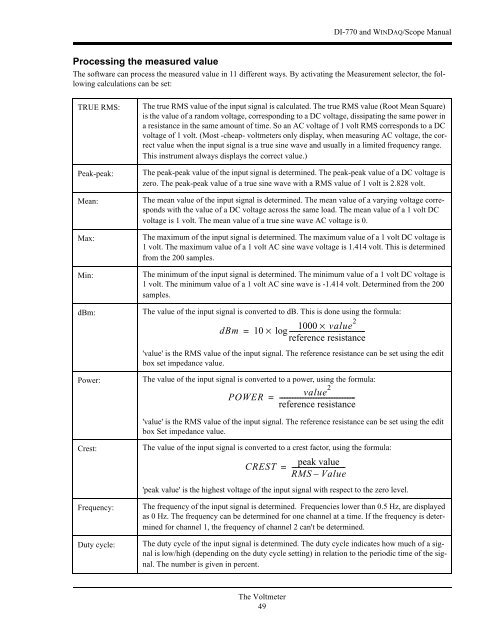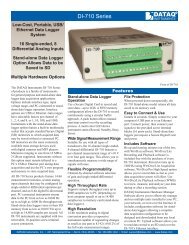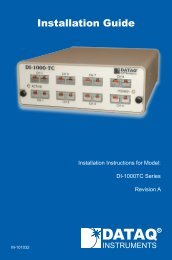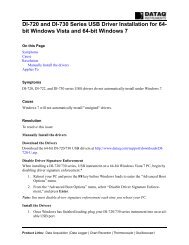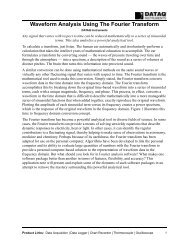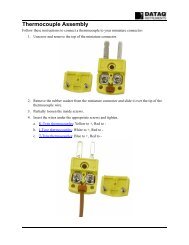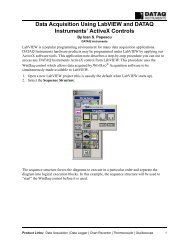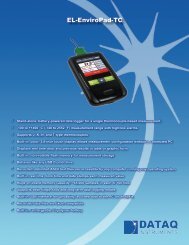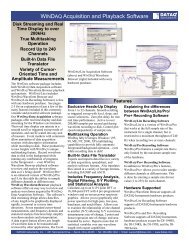DI-770 Oscilloscope provides five virtual instruments in one
DI-770 Oscilloscope provides five virtual instruments in one
DI-770 Oscilloscope provides five virtual instruments in one
Create successful ePaper yourself
Turn your PDF publications into a flip-book with our unique Google optimized e-Paper software.
<strong>DI</strong>-<strong>770</strong> and WINDAQ/Scope Manual<br />
Process<strong>in</strong>g the measured value<br />
The software can process the measured value <strong>in</strong> 11 different ways. By activat<strong>in</strong>g the Measurement selector, the follow<strong>in</strong>g<br />
calculations can be set:<br />
TRUE RMS:<br />
Peak-peak:<br />
Mean:<br />
Max:<br />
M<strong>in</strong>:<br />
dBm:<br />
Power:<br />
The true RMS value of the <strong>in</strong>put signal is calculated. The true RMS value (Root Mean Square)<br />
is the value of a random voltage, correspond<strong>in</strong>g to a DC voltage, dissipat<strong>in</strong>g the same power <strong>in</strong><br />
a resistance <strong>in</strong> the same amount of time. So an AC voltage of 1 volt RMS corresponds to a DC<br />
voltage of 1 volt. (Most -cheap- voltmeters only display, when measur<strong>in</strong>g AC voltage, the correct<br />
value when the <strong>in</strong>put signal is a true s<strong>in</strong>e wave and usually <strong>in</strong> a limited frequency range.<br />
This <strong>in</strong>strument always displays the correct value.)<br />
The peak-peak value of the <strong>in</strong>put signal is determ<strong>in</strong>ed. The peak-peak value of a DC voltage is<br />
zero. The peak-peak value of a true s<strong>in</strong>e wave with a RMS value of 1 volt is 2.828 volt.<br />
The mean value of the <strong>in</strong>put signal is determ<strong>in</strong>ed. The mean value of a vary<strong>in</strong>g voltage corresponds<br />
with the value of a DC voltage across the same load. The mean value of a 1 volt DC<br />
voltage is 1 volt. The mean value of a true s<strong>in</strong>e wave AC voltage is 0.<br />
The maximum of the <strong>in</strong>put signal is determ<strong>in</strong>ed. The maximum value of a 1 volt DC voltage is<br />
1 volt. The maximum value of a 1 volt AC s<strong>in</strong>e wave voltage is 1.414 volt. This is determ<strong>in</strong>ed<br />
from the 200 samples.<br />
The m<strong>in</strong>imum of the <strong>in</strong>put signal is determ<strong>in</strong>ed. The m<strong>in</strong>imum value of a 1 volt DC voltage is<br />
1 volt. The m<strong>in</strong>imum value of a 1 volt AC s<strong>in</strong>e wave is -1.414 volt. Determ<strong>in</strong>ed from the 200<br />
samples.<br />
The value of the <strong>in</strong>put signal is converted to dB. This is d<strong>one</strong> us<strong>in</strong>g the formula:<br />
dBm = 10 ×<br />
1000 × value 2<br />
log----------------------------------------------<br />
reference resistance<br />
'value' is the RMS value of the <strong>in</strong>put signal. The reference resistance can be set us<strong>in</strong>g the edit<br />
box set impedance value.<br />
The value of the <strong>in</strong>put signal is converted to a power, us<strong>in</strong>g the formula:<br />
POWER<br />
=<br />
value 2<br />
----------------------------------------------<br />
reference resistance<br />
'value' is the RMS value of the <strong>in</strong>put signal. The reference resistance can be set us<strong>in</strong>g the edit<br />
box Set impedance value.<br />
Crest:<br />
Frequency:<br />
Duty cycle:<br />
The value of the <strong>in</strong>put signal is converted to a crest factor, us<strong>in</strong>g the formula:<br />
CREST = ---------------------------------<br />
peak value<br />
RMS – Value<br />
'peak value' is the highest voltage of the <strong>in</strong>put signal with respect to the zero level.<br />
The frequency of the <strong>in</strong>put signal is determ<strong>in</strong>ed. Frequencies lower than 0.5 Hz, are displayed<br />
as 0 Hz. The frequency can be determ<strong>in</strong>ed for <strong>one</strong> channel at a time. If the frequency is determ<strong>in</strong>ed<br />
for channel 1, the frequency of channel 2 can't be determ<strong>in</strong>ed.<br />
The duty cycle of the <strong>in</strong>put signal is determ<strong>in</strong>ed. The duty cycle <strong>in</strong>dicates how much of a signal<br />
is low/high (depend<strong>in</strong>g on the duty cycle sett<strong>in</strong>g) <strong>in</strong> relation to the periodic time of the signal.<br />
The number is given <strong>in</strong> percent.<br />
The Voltmeter<br />
49


